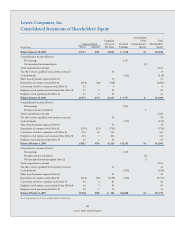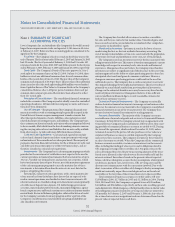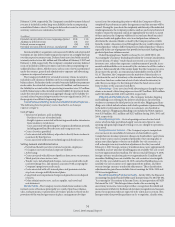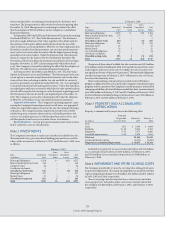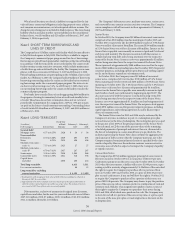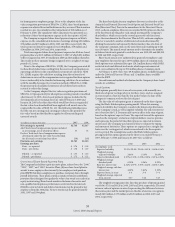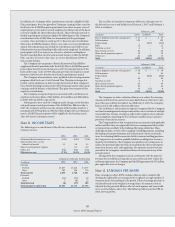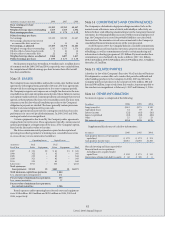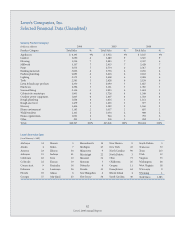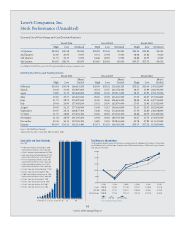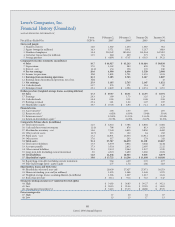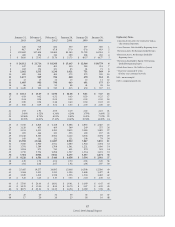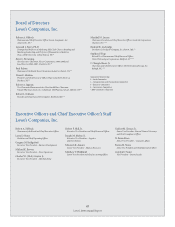Lowe's 2006 Annual Report Download - page 42
Download and view the complete annual report
Please find page 42 of the 2006 Lowe's annual report below. You can navigate through the pages in the report by either clicking on the pages listed below, or by using the keyword search tool below to find specific information within the annual report.
38
Lowe’s 2006 Annual Report
for homogeneous employee groups. Prior to the adoption of the fair
value recognition provisions of SFAS No. 123(R), share-based payment
expense was adjusted for actual forfeitures as they occurred. is transition
resulted in a pre-tax cumulative eect adjustment of $10 million as of
February 4, 2006. e cumulative eect adjustment was presented as a
reduction of share-based payment expense in the rst quarter of 2006.
e Company recognized share-based payment expense in SG&A
expense on the consolidated statements of earnings totaling $62 million,
$76 million and $70 million in 2006, 2005 and 2004, respectively. e
total income tax benet recognized was $18 million, $19 million and
$16 million in 2006, 2005 and 2004, respectively.
Total unrecognized share-based payment expense for all share-based
payment plans was $103 million at February 2, 2007, of which $51 million
will be recognized in 2007, $34 million in 2008 and $18 million thereaer.
is results in these amounts being recognized over a weighted-average
period of 1.2 years.
Prior to the adoption of SFAS No. 123(R), the Company presented all
tax benets of deductions resulting from the exercise of stock options as
operating cash ows in the consolidated statements of cash ows. SFAS
No. 123(R) requires the cash ows resulting from the tax benets of
deductions in excess of the compensation cost recognized for those options
(excess tax benets) to be classied as nancing cash ows. In accordance
with the modied-prospective-transition method of SFAS No. 123(R),
the prior period consolidated statements of cash ows have not been
restated to reect this change.
As the Company adopted the fair-value recognition provisions of
SFAS No. 123 prospectively for all employee awards granted or modied
aer January 31, 2003, share-based payment expense included in the
determination of net earnings for years ended February 3, 2006 and
January 28, 2005 is less than that which would have been recognized if
the fair-value-based method had been applied to all awards since the
original eective date of SFAS No. 123. e following table illustrates
the eect on net earnings and earnings per share in the period if the
fair-value-based method had been applied to all outstanding and
unvested awards.
(In millions, except per share data) 2005 2004
Net earnings as reported $2,765 $2,167
Add: Stock-based compensation expense included
in net earnings, net of related tax eects 57 53
Deduct: Total stock-based compensation expense
determined under the fair-value-based method
for all awards, net of related tax eects (59) (95)
Pro forma net earnings $2,763 $2,125
Earnings per share:
Basic – as reported $ 1.78 $ 1.39
Basic – pro forma $ 1.78 $ 1.37
Diluted – as reported $ 1.73 $ 1.35
Diluted – pro forma $ 1.73 $ 1.32
Overview of Share-Based Payment Plans
e Company has (a) four equity incentive plans, referred to as the “2006,”
“2001,” “1997,” and “1994” Incentive Plans, (b) one share-based plan for
awards to non-employee directors and (c) an employee stock purchase
plan (ESPP) that allows employees to purchase Company shares through
payroll deductions. ese plans contain a nondiscretionary antidilution
provision that is designed to equalize the value of an award as a result of an
equity restructuring. Share-based awards in the form of incentive and
non-qualied stock options, performance accelerated restricted stock
(PARS), restricted stock and deferred stock units may be granted to key
employees from the 2006 plan. No new awards may be granted from the
2001, 1997 and 1994 plans.
e share-based plan for non-employee directors is referred to as the
Amended and Restated Directors’ Stock Option and Deferred Stock Unit
Plan (Directors’ Plan). Prior to the amendment to the Directors’ Plan in
2005, each non-employee Director was awarded 8,000 options on the date
of the rst Board meeting aer each annual meeting of the Company’s
shareholders, which occurs in the second quarter of each scal year.
Since the amendment to the Directors’ Plan in 2005, each non-employee
Director is awarded a number of deferred stock units determined by
dividing the annual award amount by the fair market value of a share of
the Company’s common stock on the award date and rounding up to the
next 100 units. e annual award amount used to determine the number
of deferred stock units granted to each director was $115,000 and $85,000
in 2006 and 2005, respectively.
Share-based awards were authorized for grant to key employees and
non-employee directors for up to 169.0 million shares of common stock.
Stock options were authorized for up to 129.2 million shares, while PARS,
restricted stock and deferred stock units, which represent nonvested
stock, were authorized for up to 39.8 million shares of common stock.
At February 2, 2007, there were 49.8 million shares available for grant
under the 2006 and Directors’ Plans, and 1.3 million shares available
under the ESPP.
General terms and methods of valuation for the Company’s share-based
awards are as follows:
Stock Options
Stock options generally have terms of seven years, with normally one-
third of each grant vesting each year for three years, and are assigned
an exercise price of not less than the fair market value of a share of the
Company’s common stock on the date of grant.
e fair value of each option grant is estimated on the date of grant
using the Black-Scholes option-pricing model. When determining
expected volatility, the Company considers the historical performance
of the Company’s stock, as well as implied volatility. e risk-free interest
rate is based on the U.S. Treasury yield curve in eect at the time of grant,
based on the options’ expected term. e expected term of the options is
based on the Company’s evaluation of option holders’ exercise patterns
and represents the period of time that options are expected to remain
unexercised. e Company uses historical data to estimate the timing
and amount of forfeitures. ese options are expensed on a straight-line
basis over the vesting period, which is considered to be the requisite
service period. e assumptions used in the Black-Scholes option-
pricing model for options granted in the three years ended February 2,
2007, February 3, 2006 and January 28, 2005 were as follows:
2006 2005 2004
Assumptions used:
Expected volatility 22.3%–29.4% 25.8%–34.1% 31.6%–41.4%
Weighted-average
expected volatility 26.8% 31.4% 38.3%
Expected dividend yield 0.27%–0.31% 0.23%–0.28% 0.21%–0.23%
Weighted-average
dividend yield 0.28% 0.24% 0.22%
Risk-free interest rate 4.54%–4.97% 3.76%–4.44% 2.18%–3.46%
Weighted-average risk-free
interest rate 4.69% 3.81% 2.39%
Expected term, in years 3–4 3–4 3–4
Weighted-average expected
term, in years 3.57 3.22 3.27
e weighted-average grant-date fair value per share of options granted
was $8.86, $7.81 and $8.28 in 2006, 2005 and 2004, respectively. e total
intrinsic value of options exercised, representing the dierence between
the exercise price and the market price on the date of exercise, was approxi-
mately $80 million, $175 million and $76 million in 2006, 2005 and
2004, respectively.




